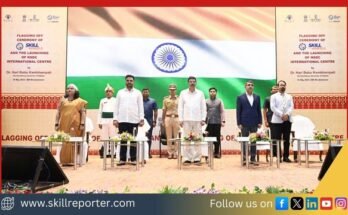In response to HT Investigation done ( to read HT Investigation, Click Here ), NSDC said that investigation is based on erroneous analysis of data, incorrect depiction of facts and lack of understanding regarding the PMKVY scheme by the author. The responses with facts and clarifications is as below –
1. Regarding the point that 34 institutes (being 0.2% of total institutes) trained 40% candidates under the Pradhan Mantri Kaushal Vikas Yojana(PMKVY)
Fact: The 34 Institutes mentioned in the article are 34 “Training Providers” and not “Training Centers”. Each “Training Provider” runs multiple “Training Centers” who are responsible for imparting the training to the candidates at the specific location. The aforesaid top 34 Training Providers have a combined 4,389 Training Centers across the country, which comprise of 33.71% of the total 13,019 registered Training Centers under PMKVY 1. These Training Centers have trained approximately 42% of the candidates under PMKVY 1, which is entirely consistent. The statement in the article is akin to stating that most of the Indians have their bank accounts in
Mumbai because the Head Offices of most of the banks is in Mumbai!
Furthermore, Softdot (seventh largest not fifth largest as quoted in the article) and Possit Skill Organisation, in particular imparted the trainings mentioned in the report through 70 and 115 Training Centers respectively across the country and not limited to NCR as indicated in the article.
2. Regarding fraudulent enrolment of candidates, non-validation of Aadhar (for more than 570,000 students) and non-existent candidates or multiple enrolments of a single candidate to inflate the total number.’
Fact: Under PMKVY 1, Aadhaar Verification was mandatory for issuance of certificate to the candidate and an Aadhaar seeded bank account mandatory for the release of reward money in the candidate’s account. As on date, 13.85 lakh candidates have been certified after Aadhaar verification and NSDC has released a total of Rs. 1077.85 crore to 10.17 lakh successful candidates in their Aadhaar seeded bank accounts only. The scheme is still open for the remaining eligible candidates to get their bank accounts Aadhaar seeded and receive the reward money or certification based only on the Aadhaar authentication. The candidates who have not appeared for assessment or failed the assessment will remain ineligible for certification or reward.
Additionally, if a candidate is enrolled more than once in the scheme, the candidate is not eligible to receive the reward money more than once even if the candidate gets certified with authenticated aadhaar id or has an aadhaar seeded bank account.
It may be noted that consequently the Training Centers also have not received any government money in respect of candidates without Aadhaar seeded bank accounts or for candidates which have received the reward amount once under the PMKVY 1.0 scheme.
Thus, if any Training Center enrolled a fraudulent candidate (candidate without verified Aadhar and non-aadhaar seeded bank account) or enrolled a candidate more than once, then it only leads to loss for the Training Center and there is no expenditure/loss of any sort on the public exchequer; neither is the candidate reported as certified.
3. On the matter regarding lack of infrastructure and identification of only 1,400 training centers under PMKVY 2.0 against the 12,181 in PMKVY-1 and increased allocation of the budget by Govt.
Fact: PMKVY 1 was initially launched for one year with the decision to scale it up in subsequent years based on learnings from the first year of implementation. Accordingly, the PMKVY 2.0 has been sanctioned for four years with a significantly higher target and revised guidelines with enhanced focus on outcomes in terms of placements, infrastructure mapping and tracking, Aadhaar based enrollments, model content, integration of life skills including soft skills, digital skills and financial literacy etc.
Additionally, as the PMKVY 1 was a candidate reward based scheme, it was designed to provide training under any job role as desired by the candidate, thus the training centers were catering to the demand from the students. However under PMKVY 2.0; only 221 job roles which have high placement demand have been identified for which the training Centers have to upgrade the training equipment and recruit appropriate trainers. The enhanced focus on quality under PMKVY 2.0 requires Training Providers to further invest and upgrade their infrastructure – both physical and trainers etc. The Scheme has now completely stabilized with more than 6,000 centers applying for accreditation under PMKVY 2.0 and a total of more than 1,900 Training Centers have been allocated targets. This number is constantly increasing with training centers upgrading and applying for being considered for targets under PMKVY 2.0.
4. Regarding the statistics on low placement (5% as quoted in the article).
Fact: Since PMKVY 1 was a reward based scheme wherein a candidate was eligible for reward based on the certification, placement tracking was not mandatory under the scheme. The data for placement was initially not collected from the Training Centers. However, with efforts in last few months NSDC has the placement data of more than 18% of the candidates.
Additionally, under PMKVY 1.0 the candidates opted for courses (and were certified) in 11 sectors which largely function in informal/unorganized manner such as logistics, retail, beauty & wellness, agriculture, etc. (76% of the total certified candidates are in 11 such sectors) where employment is not formalized or recorded with evidence/proof, thus verifiable placement documents such as
employment offer letters, salary slips, etc. are not available for training centers to submit for validation and verification by NSDC.
5. Regarding 20% (fifth of total) candidates being trained by 10 institutes with 4 of them being in NCR alone and the lack of infrastructure in the franchisee centers
Fact: The 10 Institutes referred to are Training Partners which have 2,409 Training centers spread across 28 States and 376 districts of our country and the head offices of 4 Training Partners are located in NCR not that they trained the 20% candidates in NCR alone as depicted in the article.
First Level franchise was allowed in PMKVY 1 and thus most of the Training Providers relied on franchisee model to quickly increase their geographic spread and training capacity. However, all the Training Centres were accredited and affiliated by the respective Sector Skill Councils before any training could start in these centres, thereby establishing their readiness to train at that point in time. If the candidates did not receive the requisite training then they would neither be certified nor receive the eligible reward amount, resulting into non-payment of training cost to the Training Center either thus contradicting the claims by the author about low-quality training at ill equipped training centers.
From the above-presented facts, it is clearly evident that the article referred to is entirely misleading and maligning the integrity of NSDC and the objectives of the PMKVY scheme to provide quality skill training to the unemployed youth of the nation. This also indicates clearly a lack of understanding of the author regarding the skills space and implementation nuances of the scheme.
For any further queries or information, please write to CEO, National Skill Development Corporation, Block-A, Clarion Collection (Qutab Hotel), Shaheed Jeet Singh Marg, New Delhi – 110 016 or send an email to ceo@nsdcindia.org.




